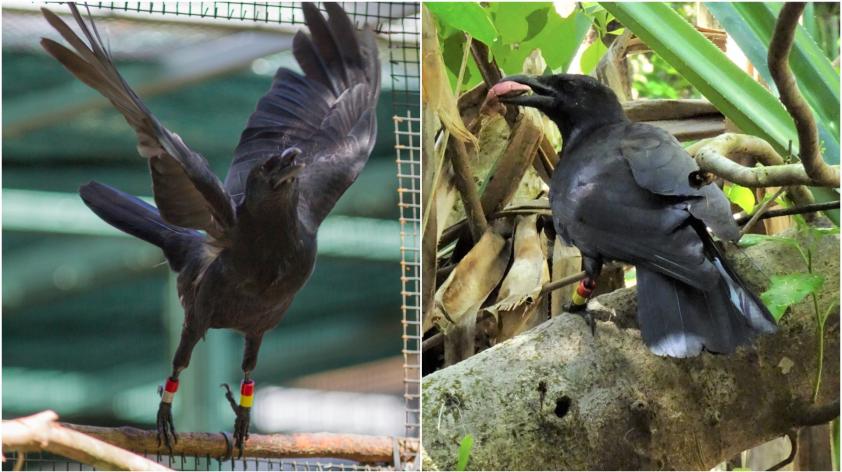
Aga Release Blog Part 1: Eating Hermit Crabs and Exploring the Jungle
This is a blog post about work being done by San Diego Zoo Global and the University of Washington, rearing and releasing Mariana crows (Aga) on the Island of Rota, Commonwealth of the Northern Mariana Islands (U.S.A.). These Aga have been captive-reared by San Diego Zoo Global here on Rota, from eggs that were pulled from wild nests (the wild Aga then go on to lay more eggs), hatched in captivity, and raised in large outdoor aviaries. While in captivity, Aga are prepared for life in the wild through a system of native food provisioning, studying the social structure of the cohorts, anti-predator training, and monitoring health and readiness for release. They are now two years old (an age at which they are less susceptible to wild threats) and are being released by San Diego Zoo Global and the University of Washington.
The purpose of this rear-and-release project, which is funded by CNMI DLNR and USFWS, is to jump start an increase in the Aga population which currently is at 175 individuals (all on the island of Rota). The Aga has lived on Rota for approximately two million years. It survived 3000 years with the native Chamorro peoples on the island, followed by nearly 500 years of tumultuous periods since the Spanish discovered and introduced the Mariana Islands to Western cultures. Over the past 4 years we have seen the Aga population stabilize, albeit at a very low number, and with this rear and release program we are hoping the population will now increase.
The Aga’s First Week Post-Release
The 5 released Aga have survived their first week in the wild. Far from merely surviving, they are thriving! They are hunting hermit crabs, mobbing monitor lizards, navigating the social complexities of their own flock and of the wild Aga with whom they share the jungle. These individuals, most of whom I have known since the day they hatched, became different creatures almost overnight. Shy little “OOOA”, the third egg who never would have made it in the wild (wild Aga only raise 1 or 2 young)—she was the first one out of the release aviary!
None of the birds hesitated for long when that door to the jungle opened. Within 2 minutes, all 5 had emerged and begun their explorations.
Like toddlers in a toy store, they jumped from perch to perch—a dead log to dig at, some rolled leaves that might contain insects, a hermit crab whose shell might be a little weak. They peered into nooks and crannies, searching for lizards and insects, drinking from a pool of rainwater. They hopped, swooped, and tumbled as they explored their new habitat, from the ground to the tops of the tallest trees, calling to each other with excitement—rattles and squawks, yells and cries.
One week after the doors were opened, the birds have settled into their new environment and are exploring more methodically. We are seeing some patterns and routines emerge: They are primarily exploring the jungle to the east of the release site. And they are primarily eating hermit crabs. During radio-tracking sessions I’ve repeatedly found four of the five released crows about 600 meters from the release aviary, in a patch of jungle dominated by Eugenia (a short, wiry native tree). As I walk through this area, following the beeping on my telemetry receiver, I note that the trees and shrubs are mostly native and that the walking is surprisingly pleasant—the understory is relatively open.
There is no need to crawl, which is a change for the better compared to many areas of the island where thorny thickets of non-native Triphasia block any hope for a grown human to walk upright. I also notice the hermit crabs…there are so many that I actually stumble over several. While hermit crabs (Coenobita species) are common across the entire island, they usually remain hidden during daylight hours. In this area, they seem to be ambling about at all hours. Every hermit crab I see is housed within an African snail shell—a weaker type of shell which Aga are able to open. It’s no wonder, I think to myself, that we’ve watched our released Aga eat hermit crabs on 6 separate occasions already.
The beeps on my receiver get louder as I approach OOOA. But before I can get eyes on her, I hear the calls of 2 Aga, flying over the canopy from the east. It’s two more of our released Aga. They must have been 600+ meters from the release site and are now flying overhead, back towards the release site.
They pause briefly in the treetops, just long enough for me to read their bands (YAOW and WWAG, our male/female pair), before they take off again, disappearing from sight over the treetops, wingtip to wingtip, their calls trailing behind them and fading into the distance.
Already, the loud and raucous calls of these 5 Aga have transformed this patch of jungle, where wild Aga are few and far between. In two weeks, another 5 Aga will be released at the same location. And as these releases mark the successful culmination of captive-rearing for these individuals, they are also mark the beginning—a beginning of life in the wild.
Here’s wishing these 10 Aga long lives and a welcome to the island community!
-----
For additional updates on the Aga of Rota, please visit the Mariana Crow Recovery Project Facebook page.
Photos by Henry Fandel and Sarah Faegre.













